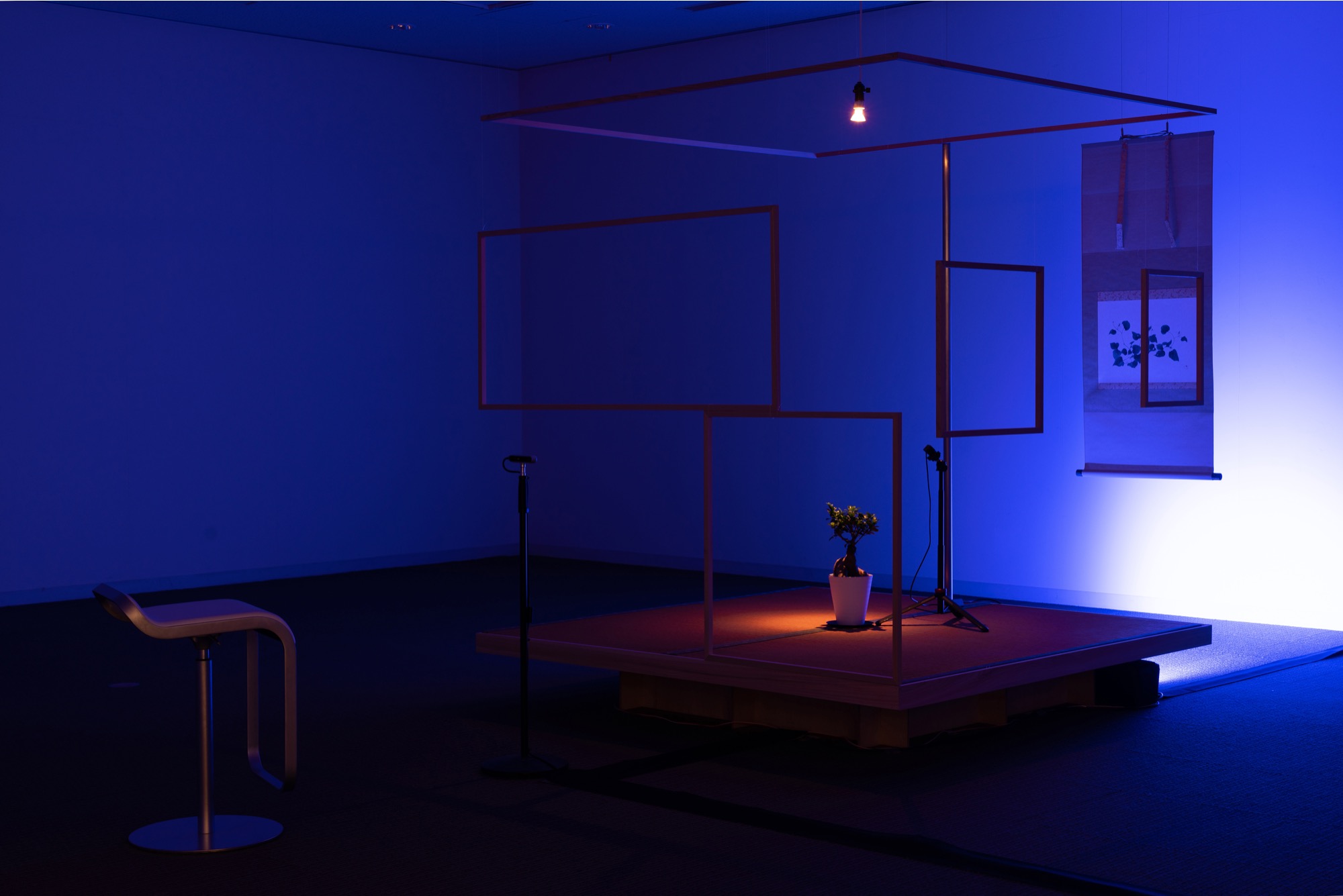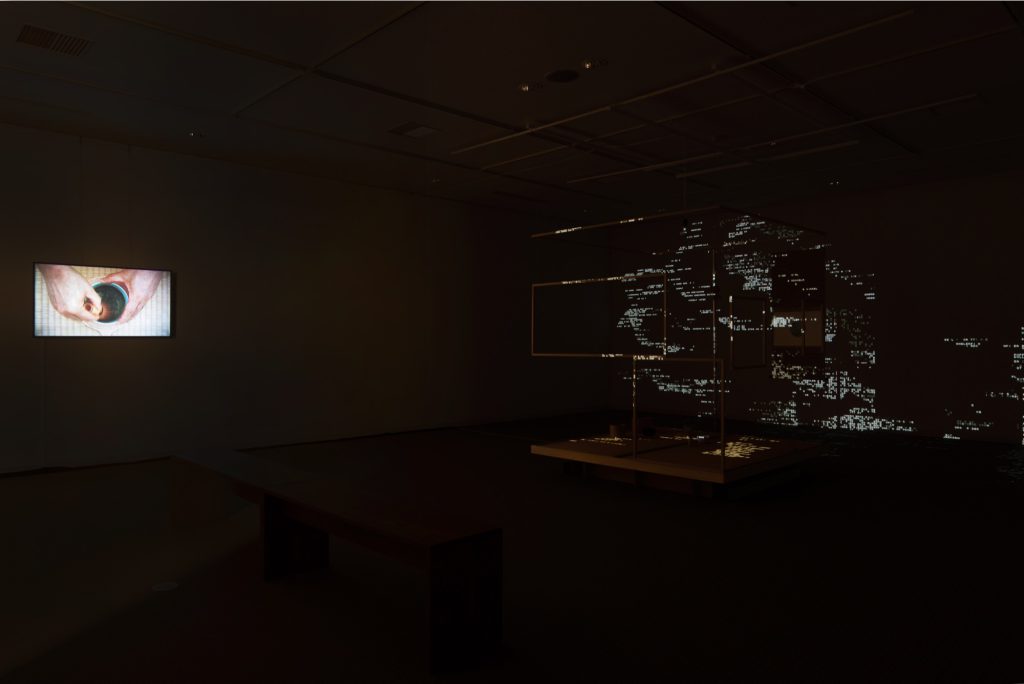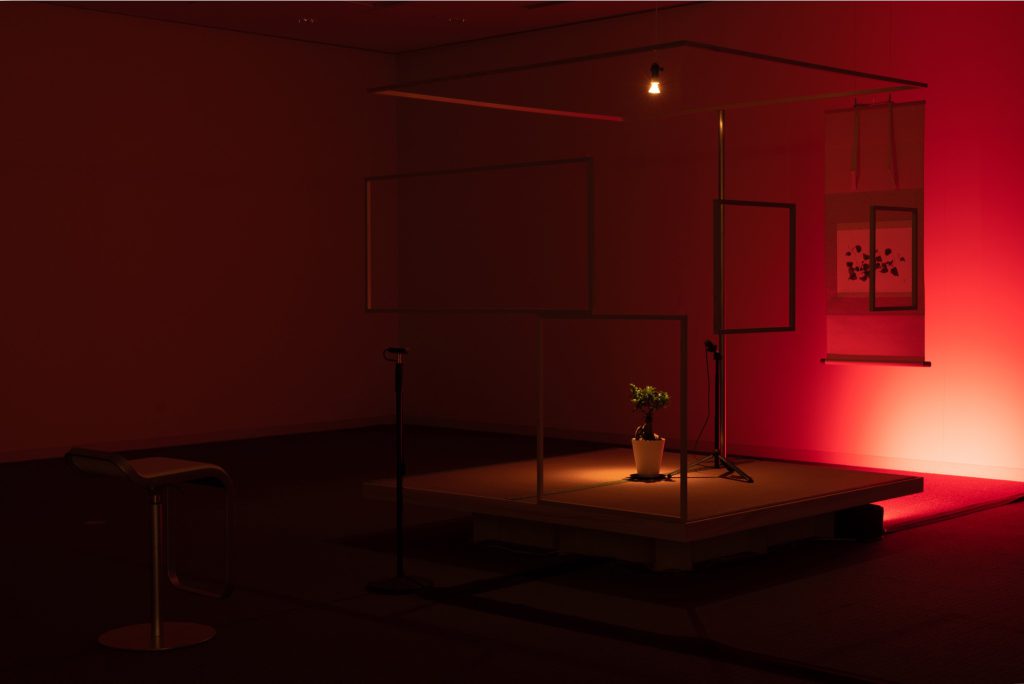待庵 waiting-cabin

2022.03.04–2022.03.06
Horikawa-Oike Gallery, Kyoto, Japan
「人類は地球を離れて、遥か彼方の惑星コロニーに移住することになった。移住にあたっては、宇宙船やコロニーの居住空間のキャパシティーから、限られた物資しか持参することができない。そんな中で、許された数少ない物資が茶道具をコンパクトに収納した茶箱と鉢植えの生きた植物であった。人々は地球から遥か遠く離れた場所で、この茶道具を用いた茶事と生きた植物との対話を行い地球を想う。」
以上のようなフィクショナルな設定に基づく二つの作品《waiting-cabin 宇宙茶道》および《waiting-cabin 宇宙瞑想》を構想した。共に宇宙から地球を想うための装置 であるが、前者は茶道における茶事を通じて地質学的な「地球」の時間に触れるものあり、後者は呼吸瞑想を通じて「植物」と時間を共有する試みである。21世紀に入り、温室効果ガスによる気候変動や環境汚染による生態系の異変など、地球規模での破壊的事態が加速し深刻化している。人間中心主義を無自覚に擁護してきた私たちの営みが、地球の地質年代にまで影響を与え生態系の破壊を加速している、という危機的な状況認識が共有されつつある。パウル・クルッツェンらによって提唱された「人新世」という地質年代の提案を起点として、改めて「人と自然」の関係を問い直そうとするポストヒューマンの探究が、多様な領域において行われ始めた。本展覧会もこうした人類全体に関わる問題意識を共有するものであり、とりわけ「人と地球」「人と植物」の関係について、芸術の立場からのアップデートを目指すものである。
Humanity has decided to leave Earth and migrate to a faraway planetary colony. When we emigrate, we can only bring a limited number of supplies with us due to the capacity of the spaceship and the colony’s living space. The few supplies we were allowed were a tea box containing a compact set of tea tools and a single potted live plant. In a place far from the Earth, people held tea ceremonies using these tea tools and communicated with the living plant to think about the Earth.”
Based on the above fictional setting, we conceived of two works, “waiting-cabin Space Tea Ceremony” and “waiting-cabin Space Meditation”. Both are devices to contemplate the earth from space, but the former is an attempt to touch the geological time of the “earth” through the tea ceremony, and the latter is an attempt to share time with “the plant” through breathing meditation. Destructive situations are accelerating and becoming more serious.There is a growing shared awareness of the critical situation: our unintentional development based on anthropocentrism is accelerating the destruction of ecosystems, affecting even the geological age of the earth. Starting from the proposal of the “Anthropocene” geological age proposed by Paul Crutzen and others, post-human exploration to reexamine the relationship between humans and nature has begun to take place in a variety of fields. This exhibition shares this awareness of issues that concern humanity as a whole, and in particular aims to update the relationship between “people and the earth” and “people and plants” from the standpoint of art.
《waiting-cabin 宇宙茶道》
本作品は、地球から遠く離れた宇宙の彼方にあって、茶事を通じて地球を想うための場を想定したものである。待庵 をモチーフとするミニマルな茶室において、茶箱にコンパクトに収めた茶道具類 を用いて亭主と客が茶を喫する。言うまでもなく、茶の原材料である茶葉は地球で育ったものであるが、各茶道具の原材料である木材や粘土、ガラス、布、金属なども地球において産出されたものである。こうした素材が46億年に及ぶ地球の歴史によって育まれたことに思いを馳せながら、職人たちの手によって精緻かつ美しく造形された茶道具類を用いて茶事を行うのである。
本作品では、客の入りから亭主が茶を喫するまでのプロセスを記録した映像を用い、映像に含まれる音声(茶室にて発せられる音)をトリガーとして、地球における46億年の歴史をデータを用いて視覚化する。地球誕生から生命の誕生(0-6億年)、大酸化イベント(24億年)、スノーボールアース・イベント(39億年)、カンブリア大爆発(40億年)、超大陸の誕生、恐竜の登場(43億年)、恐竜の絶滅(45億年)を経て、人類の誕生(46億年)に至るまで、人智を遥かに超える地球の壮絶な変化の歴史を、茶事に重ねて振り返る。
地球の環境は、過去数回にわたり激しく変化したことが明らかになっている。例えば超寒冷化現象「スノーボールアース・イベント」では、地球上の水が全て凍結(全球凍結)し、それまで繁栄していた生物の多くが絶滅したとされている。一方、急激な環境変化を生き抜いた一部の生物は、新しい環境に適応して進化するとともに、生物の爆発的な多様化へとつながった。こうした生物の絶滅と多様化は、化石によって検証可能な顕生代(約5億4100万年前〜現在)に5回起こっている。顕生代前期の古生代オルドビス紀末(約4億4000万年前)、古生代デボン紀後期(約3億7000万年前)、古生代ペルム紀末(約2億5200万年前)、顕生代中期の中生代三畳紀末(約2億年前)、中生代白亜紀末(約6600万年前)がそれに該当する。いずれも人類の歴史から見れば気の遠くなるような過去の出来事であり、私たちの時間感覚からかけ離れた無縁の出来事のように感じてしまう。しかし顕生代後期第四紀、完新世の末期にあたる現在は、第6回目の大量絶滅の最中にあると言われており、決して無関係とは言えない。しかも、これまでの人類の営みによって、地質年代のタイムスケールから見れば極端に短い期間に、多くの生物種が絶滅しているのである。そして今後もこれまで以上の速さで、さらに多くの生物種が絶滅すると予想されている。このまま人類が経済的な繁栄とそれに伴う乱開発を止めることができなければ、人類を含めた多くの生物種の絶滅の痕跡が「人新世」の地層に刻まれることになるだろう。人類に起因しながら人類に解決できない問題、それは人類が次の新しい人類(ポストヒューマン)へと進化する時を「待つ」以外に解決の方法がない。
waiting-cabin space tea ceremony
In a minimalist space inspired by Japan’s oldest tea house, the “Taian”, the tea ceremony is performed by the host and guests using tea utensils compactly stored in a tea box. Needless to say, tea leaves, the raw material of tea, are grown on the earth, and wood, clay, glass, cloth, and metal, the raw materials of tea utensils, are also produced on the earth. The tea ceremony is performed using tea tools, which are exquisitely and beautifully crafted by artisans, while remembering that these materials have been nurtured over 4.6 billion years of the Earth’s history.
In this work, the process from the guests’ entrance to the tea ceremony by the master is recorded on video, and the audio contained in the video (sounds made in the tea room) is used as a trigger to visualize the history of 4.6 billion years on the earth using data. From the birth of the Earth to the birth of life (0-600 million years), the Great Oxidation Event (2.4 billion years), the Snowball Earth Event (3.9 billion years), the Cambrian Explosion (4 billion years), the birth of supercontinents, the appearance of dinosaurs (4.3 billion years), their extinction (4.5 billion years), and the birth of human beings (4.6 billion years), far exceeding human knowledge The history of the earth’s spectacular changes is recounted over tea ceremonies.
It is clear that the Earth’s environment has undergone violent changes several times in the past. For example, in the “Snowball Earth Event,” a super cold event, all water on the earth froze (global freezing), and many organisms that had previously thrived on the earth are believed to have become extinct. On the other hand, some organisms that survived the rapid environmental change adapted to the new environment and evolved, leading to an explosion of biological diversification. Such extinctions and diversification of organisms occurred five times during the Phanerozoic Era (approximately 541 million years ago to the present), which can be verified by fossils. These include the end of the Paleozoic Ordovician (about 440 million years ago), the end of the Paleozoic Devonian (about 370 million years ago), the end of the Paleozoic Permian (about 252 million years ago), the end of the Mesozoic Triassic (about 200 million years ago) and the end of the Mesozoic Cretaceous (about 66 million years ago) during the early Phanerozoic. From the perspective of human history, these events seem to be far away from our sense of time and unrelated to our own. However, the Late Quaternary of the Phanerozoic Era, the end of the Holocene Era, is said to be in the midst of the sixth mass extinction event, so they are by no means unrelated to each other. Moreover, human activities to date have caused the extinction of many species in an extremely short period of time in terms of the timescale of geological ages. And it is predicted that many more species will become extinct in the future at an even faster rate than before. If human beings are unable to stop their economic prosperity and the overexploitation that accompanies it, the traces of the extinction of many species, including humans, will be etched in the strata of the “Anthropocene”. There is no other way to solve the problems that are caused by humans but cannot be solved by humans, except to “wait” for the time when humans evolve into the next new human species (post-humans).


《waiting-cabin 宇宙瞑想》
本作品は、人と植物の生体反応に基づく体験型のインタラクティヴ・アート作品である。先に紹介した《waiting-cabin 宇宙茶道》と同じく、待庵をモチーフとする茶室を用いているが、ここでは人(亭主)と人(客)が茶事を通じて関わり合う場ではなく、人(亭主)が瞑想を通じてと植物(客)と関わり合う場とした。
数ヶ月あるいは数年間、狭い閉鎖的な宇宙船内で過ごすのは過酷以外のなにものでもない。宇宙船の外には、マイナス270度の果てしなく広大な空気(酸素)のない空間が広がっている。もし宇宙服なしで外に出たら、数秒で意識を失い3分ほどで死に至ってしまう。たとえ宇宙船内に留まっていたとしても、船体になんらかのトラブルが起これば、たちまち生存が危うくなってしまう。おそらく地球上のどんな場所と比べても、はるかにストレスフルな場所であるに違いない。こうした状況で精神を安定させ平穏を保つためには、呼吸を意識した瞑想法 が有効であろう。そこで本作品では、誰もが簡単に瞑想体験ができるように、光と音による呼吸瞑想支援システムを開発した。呼吸に伴う鑑賞者の胸腹部の膨らみを深度センサー用いてセンシングし、呼吸と連動してLED照明の明るさを変え、ソフトウェア音源の音量を変えるシステムである。作品の体験者は、光の変化によって自身の身体が広がったり縮んだりするかのような感覚や、音の変化によって身体が弦の震えのように振動する感覚を楽しみ、やがて自身の身体と光・音とが溶け合い一体化する感覚を味わう。
《waiting-cabin 宇宙瞑想》では、この呼吸瞑想を支援するシステムに、植物の生体反応を光と音に変換するシステムを組み合わせた。鑑賞者の呼吸によって生じた光を植物に照射することで植物に温度変化が生じ、その温度変化の値を新たな光と音に変換する。すると鑑賞者の呼吸に起因する光と音が、植物の生体反応を起因とする光と音に重なり、両者による光と音のセッションが実現する。いわば人と植物の対話のためのシステムである
ところで動物哲学を専門とするフロランス・ビュルガは、植物の生の再定義を試みている。近年、植物に対して感覚や知覚の存在を認めることによって、植物を擬動物的あるいは擬人的に解釈するケースが増えている。しかしビュルガはこうした態度に距離を置きつつ、「限界がなく、無関心で、自らに不安を感じていない植物と、個体性を持ち、精神性があり、自由に自発的に動き、誕生と死に区切られた限りある時間に生き、自らに不安を感じている動物」を比較する過程において、「意識主体としての人間」に対して植物は「本質的な他者」であり、「わたしたちにとっての植物は、どこにであもるもっとも身近な存在であると同時に、もっともかけ離れた存在でもある」(フロランス・ビュルガ)としている。そして、人間と植物の存在論上の断絶を乗り越える方法の一つは、私たちが植物の美しさを経験することだと述べている。本作品は、この「もっとも身近な存在」でありながら「もっともかけ離れた」他者としての植物の生に着目し、ビュルガが提案する植物の美しさの経験を目指すものである。ただしここでの美は植物の姿形を対象とするのではなく、植物が環境条件の変化に合わせて適応する際の生体反応を対象とした。
光を植物に照射すると、植物に温度変化が生じる。多くの場合、光による熱の照射を受けた葉が、急激な温度変化を避けるために気孔から水蒸気を発散して温度の恒常化を行う。こうした生体反応は、動物における脳の指令に基づく行為・行動とは異なり、極めて緩慢で遅延した反応である。動物の呼吸は肺と肺を収縮させる筋肉によって強制的に吸排気が行われるが、植物の呼吸あるいは光合成は、環境に浸りながら 環境の変化に合わせてじわじわと反応するパッシブなシステムであり、反応という点において動物と全く異なる時間スケールを生きている。この点に、植物特有の美を見出そうとすることが、本作のねらいなのである。私たちが植物の時間を経験するには、気長に植物の反応を「待つ」しかない。人にとっては非常にじれったい時間ではあるが、この時間スケールの差異の経験こそが、植物に固有の生のシステムに関わることであり、植物のもう一つの美を経験することなのだ。それはダナ・ハラウェイが「コンポスト主義」 と呼ぶ生存戦略の方法ともつながるはずである。
我々は、森羅万象と共振し、ともに詩作活動を行うようなかたちで類縁関係をつくらねばならないし、我々が誰であるにせよ、何であるにせよ、地上に縛りつけられた存在とともに、何かをつくり、生成変化を行い、組成作業を行わねばならないということだ。(ダナ・ハラウェイ)
waiting-cabin space meditation
This work is an experiential interactive artwork based on the biological responses of humans and plants.Like “waiting-cabin Space Tea Ceremony” introduced earlier, it uses a tea room with a “Taian” motif, but instead of a place where people (host) and people (guest) interact with each other through the tea ceremony, it is a place where people (host) interact with the plant (guest) through meditation.
Spending months or even years in a cramped, closed spacecraft is nothing short of harsh. Outside the spacecraft is a vast, endless, airless (oxygen-free) space of minus 270 degrees Celsius. If you go outside without a spacesuit, you will lose consciousness within seconds and die within about three minutes. Even if you stay inside the spacecraft, any trouble with the hull would immediately endanger your survival. It is probably a much more stressful place than any other place on earth. In order to stabilize the mind and maintain peace in such a situation, meditation with awareness of the breath would be effective. In this work, therefore, we have developed a breath meditation support system using light and sound so that anyone can easily experience meditation.
The system uses a depth sensor to sense the expansion of the viewer’s chest and abdomen as he or she breathes, and changes the brightness of the LED lighting and the volume of the software sound source in conjunction with the breathing. Visitors to the work enjoy the sensation of their own body expanding and contracting as the light changes, and their body vibrating like the trembling of strings as the sound changes, and eventually experience the sensation of their own body, light, and sound melting and becoming one.
In “waiting-cabin Space Meditation,” a system that converts the biological reactions of the plant into light and sound is combined with a system that supports this breathing meditation. The light generated by the viewer’s breathing is irradiated onto the plant, causing temperature changes in the plant, which are then converted into new light and sound. The light and sound caused by the viewer’s breathing are then superimposed on the light and sound caused by the plant’s biological reactions, and a light and sound session is realized by both. In other words, this is a system for dialogue between humans and plants.
Irradiating plants with light causes temperature changes in plants. In many cases, leaves exposed to light-induced heat emit water vapor through their pores to avoid sudden temperature changes, thereby achieving temperature homeostasis. These biological reactions are extremely slow and delayed, unlike the brain-directed actions and behaviors in animals. While respiration in animals is forced by the lungs and muscles that contract the lungs, respiration or photosynthesis in plants is a passive system that slowly responds to environmental changes while immersing itself in the environment, living on a completely different time scale from animals in terms of response. The aim of this work is to find the unique beauty of plants in this point. The only way for us to experience plant time is to patiently “wait” for plants to respond. This is a very frustrating time for people, but it is the experience of this difference in time scale that allows us to relate to the plant’s unique life system and to experience another kind of beauty in the plant.

茶道具制作
茶道具デザイン:Barbara Schmidt(プロダクトデザイン)、風呂敷印刷:Madeleine Marquardt(シアノプリント)、茶箱一式:橋村 佳明(曲物)、仕覆ほか:北村 徳齋(仕覆)、茶器:石田 知史(ガラス工芸)、茶器蓋:三木 啓樂(漆塗)、茶碗:四代 諏訪 蘇山(陶芸)、振出ほか:白川 三枝(陶芸)、風呂敷デザイン:高木 毬子(情報デザイン)、花:矢野 洋輔(木彫)、モックアップ:成安造形大学ファブコ(3D プリント)
出演・制作スタッフ
正客:高木 毬子、亭主:森 公一、茶道監修:安田 ゐう子、撮影監督:武村 敏弘、照明:古川 昌輝、美術:二瓶 晃、音響:森 祐介、助監督:増田 絢子、撮影助手:神谷 麻歩、録音:和田 美咲、編集:三浦 志緒理、茶道アシスタント:木田 枝里、撮影アシスタント:村山未畝、演出アシスタント:石川 夢乃、協力:同志社女子大学msc、監督:森 公一
Tea ceremony utensils production
Tea set design by Barbara Schmidt (Product Design), Furoshiki printing by Madeleine Marquardt (Cyanoprint), Tea box set by Yoshiaki Hashimura (Magemono), Cover and others by Tokusai Kitamura (Fukusa), Tea bowls by Tomofumi Ishida (Glass Art), Tea lid by Keiraku Miki (Lacquer), Tea bowls by Suwa Sosan IV (ceramics), Furisode and others: Shirakawa Mie (ceramics), Furoshiki design: Takagi Mariko (information design), Flowers: Yano Yosuke (wood carving), Kakejiku: Mori Koichi (photography), Tea box mock-up: Seian University of Art and Design Fabco (3D printing)
Production Cooperation
Shingo Tanaka, Akira Nihei, Takehiko Hoshi, Yuko Yasuda, Studio Aqua Inc.